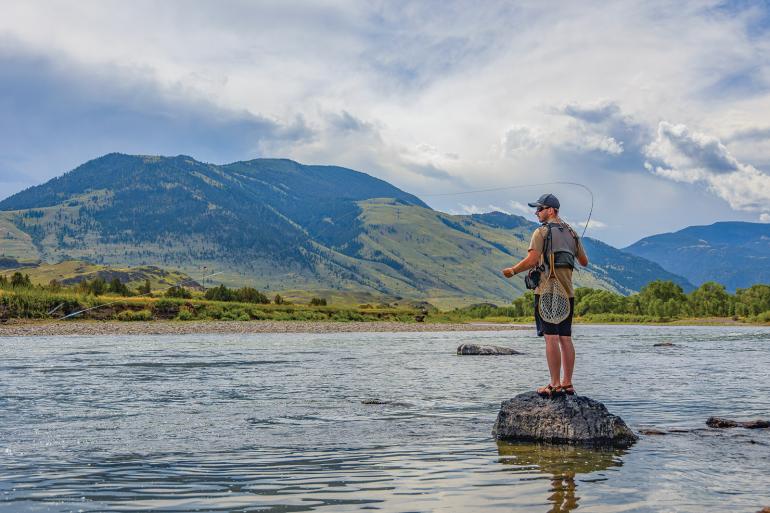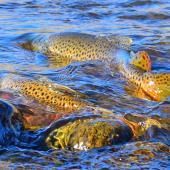Upper Yellowstone: Living the Dream
The insider scoop on an iconic trout stream.
For fly anglers, just hearing the name “Yellowstone” brings to mind images of snow-capped peaks and casting to rising cutthroat while elk bugle and eagles soar in the background. While other rivers often fail to live up to the fantasy, the upper Yellowstone can fulfill that dream and much more. Forming at Yellowstone Lake and winding north for nearly 700 undammed miles, the Yellowstone River is a mecca for wild trout—and the 80-mile upper stretch flowing between Gardiner and Livingston is the fishery’s beating heart. With plunging pools, bubbling riffles, and deep runs chock-full of grabby fish, the section of the Yellowstone flowing through the iconic Paradise Valley is part of the reason the area was given its name.
Access
There’s a huge amount of access available along the Yellowstone’s upper section, with over 20 official FWP access sites running from the northern border of Yellowstone National Park downstream through Livingston. However, since the 2022 flooding, several of these sites have been closed, so be sure to check current status when planning a trip. In addition to the official sites, there are also several pieces of public land along Hwy. 89 with river access that are perfectly legal to fish. These sites typically don’t have boat ramps, so are best for wade anglers or those with light, portable watercraft.
The southern portion, between Gardiner and Yankee Jim Canyon, is made up of pocket water, rapids, and riffles that offer some of the best dry-fly action in the entire river system, with high populations of trout in close proximities. However, this section can also be quite technical and challenging for inexperienced anglers. Below Yankee Jim, the river widens up and slows down, offering easier wading, rowing, and fishing with long meandering pools, foamy back-eddies, and boulder-strewn runs making up most of the river—all of which hold plenty of fish.
Flows
The Yellowstone is a freestone river and thus susceptible to the whims of nature, so flows can vary greatly from month to month, and sometimes even from day to day. A couple nights of heavy rain or a few days of warm, snow-melting weather in the surrounding mountains can transform the upper Yellowstone from clear and tranquil to a raging brown torrent in just a few hours. Therefore, it’s best to avoid this section of river during peak runoff, which ranges from mid-May to early July (when flows can exceed 20,000cfs), or anytime the area has received a large amount of precipitation. However, the post-runoff time, when flows have dropped below 10,000cfs, can be some of the best fishing of the year. Flows between 5,000cfs and 3,000cfs are considered ideal.
From late July to early September, flows usually remain consistent, though rainstorms in the Lamar Valley in Yellowstone Park often send plugs of mud flowing downstream, affecting water clarity and occasionally making the river unfishable. It’s best to pay close attention to the USGS website and note any recent spikes in flows before planning a trip. Additionally, when flows drop below 2,000cfs during the summer, water temperatures can often exceed 68 degrees. This often means that the Yellowstone is put under hoot-owl restrictions (fishing prohibited between 2pm and midnight), which limits fishing time but ensures that fish aren’t put under any unnecessary stress, and that populations remain stable and healthy during peak fishing pressure.
When to Go
The Yellowstone offers excellent fishing for almost the entire year. In March and April, when the ice begins to melt and water temperatures climb into the upper 30s and 40s, both midge and blue-winged olive hatches create some fantastic fishing with nymphs and dry flies. This is especially true on blue-sky days when there’s a lot of sunlight on the water and air temperatures are tolerable. Then in late April and early May, the Mother’s Day Caddis Hatch begins. This hatch can be so prolific that the river looks like it’s covered in tan-colored snow, as thousands of bugs emerge, breed, and die on the surface of the water. The trout gorge themselves during this time, which is a good thing, as the beginning of runoff happens soon after, often rendering the Yellowstone completely unfishable until late June or early July. However, once runoff peters out, both salmonfly and golden stonefly hatches begin. This creates excellent opportunities for anglers to bang the riverbanks with chunky fly patterns—so long as the river has cleared enough for the trout to see them. By mid-July, the stoneflies start to dwindle but are quickly replaced by hoppers, beetles, and flying ants. These large terrestrial insects become the focus for the Yellowstone’s trout population well into September.
Early fall sees the coming of the mayflies, with large drakes, PMDs, and blue-winged olives continuing to bring fish to the surface well into mid-October. However, as winter air temperatures begin to drop in late fall, anglers should put the dry flies away and cast larger chunks of meat in the form of streamers. This is especially true in November, when the river’s famous brown trout begin their spawning run and become extremely aggressive. Anglers can continue to have luck on the Yellowstone during the winter (so long as the river remains ice-free) by fishing small midge and stonefly patterns. The fishing can be slow and the weather conditions brutal during this time of year, so it’s not for the faint of heart; but concentrating fishing efforts around hot springs or spring creeks can produce some great results.
Covering water from either a driftboat or raft, anglers floating the Yellowstone can ply the river with dry flies, nymphs, and streamers while taking in the breathtaking views of the Paradise Valley along the way.
Fish
One of the most popular things about the Yellowstone is that it has its own unique species of trout: the Yellowstone cutthroat. Present in all of the river’s tributaries, these gorgeous members of the cutthroat fraternity are quick to rise, and can reach some surprisingly large sizes. Alongside the cutties in the upper Yellowstone are vast numbers of hardy rainbow and hybrid cutbow trout, which fight like demons and tend to leap from the water like salmon when hooked. Brown trout are also here, though not in great numbers, with many specimens growing more than 20 inches. Finally, we have the ever-present mountain whitefish, whose high populations and voracious feeding habits almost guarantee that a few will come to the net of every angler who fishes this stretch.
Row vs. Wade
Anglers can have great results whether wading or floating on the Yellowstone, so fishing style depends entirely on angler preference. Those choosing to wade can thoroughly work pools and runs, and on days when the fishing is good, can have a 20-fish day in only a small section of water. Floating, on the other hand, can be an incredible experience in both fishing and beauty. Covering water from either a driftboat or raft, anglers floating the Yellowstone can ply the river with dry flies, nymphs, and streamers while taking in the breathtaking views of the Paradise Valley along the way. Anglers may even be sharing the water with the local wildlife, as sightings of deer, elk, eagles, bears, and even the occasional bison or moose are not uncommon.
Regs
The Yellowstone River is catch-and-release only for cutthroat from the Park boundary to Pine Creek Bridge. All other species have varying regulations which should be checked with Montana FWP before hitting the water.
Getting There
From Bozeman, take I-90 east to Livingston exit. Then head south on Hwy. 89 alongside the river, with fishing access available all the way to the Park.
Kubie Brown is an outdoor guide and writer living in southwest Montana.












